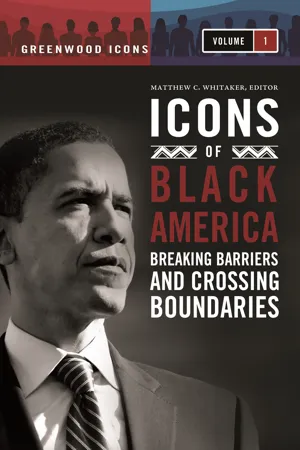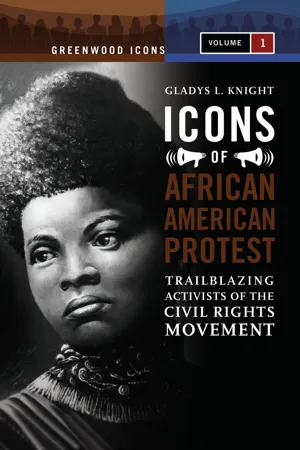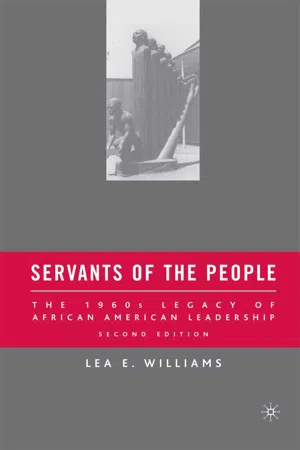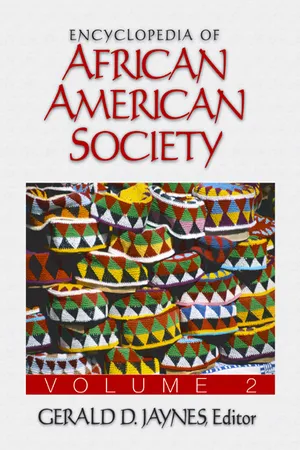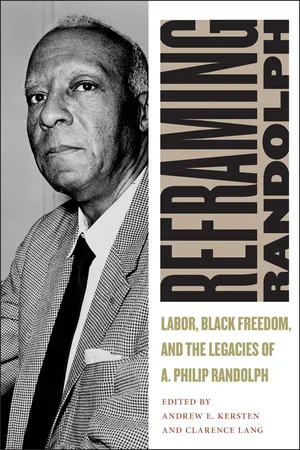History
A. Philip Randolph
A. Philip Randolph was a prominent African American civil rights leader and labor organizer. He founded the Brotherhood of Sleeping Car Porters, the first predominantly African American labor union. Randolph was a key figure in the civil rights movement and played a significant role in advocating for fair labor practices and racial equality in the United States.
Written by Perlego with AI-assistance
Related key terms
1 of 5
8 Key excerpts on "A. Philip Randolph"
- eBook - PDF
Icons of Black America
Breaking Barriers and Crossing Boundaries [3 volumes]
- Matthew Whitaker(Author)
- 2011(Publication Date)
- Greenwood(Publisher)
A. Philip Randolph (1889–1979) Library of Congress From 1925 to 1965, A. Philip Randolph was a force in both the American labor movement and the Civil Rights Movement. During this period, he was a major transitional figure in successfully leading African Americans in their quest for politico-economic freedom from legal discrimination in the mid-twentieth century. Randolph is one of the first leaders to successfully embrace socialism and infuse it with black activism. In 1925, as a trade union advocate, he suc- cessfully organized the Brotherhood of Sleeping Car Porters (BSCP). By 1929, it became the first African American union to be incorporated into the Ameri- can labor movement with a semi-autonomous charter within the American Federation of Labor (AFL). Eight years later, the BSCP broke precedent to become a completely autonomous black union within the AFL and the Pullman Company—complete with collective bargaining power. In addition, as a civil rights leader, Randolph was very effective in pioneer- ing direct-action politics and applying Gandhian tactics of nonviolent civil disobedience to protests and mass demonstrations that flourished in the 1950s–1960s. His most notable achievements in this field include being the chief organizer of the March on Washington Movement during World War II and during the Civil Rights Movement, and pressuring President Harry S. Truman into desegregating the U.S. Armed Forces in 1948. Asa Philip Randolph was born on April 15, 1889, in Crescent City, Florida, the second son of James and Elizabeth Randolph. James was a struggling AME minister, and Elizabeth was a housewife raising her sons. Despite their hard- ships, Randolph and his brother William were raised to respect themselves, respect others, and respect learning. They were also raised to fight social injus- tice and inequality whenever it was encountered. In 1891, the Randolphs moved to Jacksonville, Florida. - eBook - PDF
Icons of African American Protest
Trailblazing Activists of the Civil Rights Movement [2 volumes]
- Gladys L. Knight(Author)
- 2008(Publication Date)
- Greenwood(Publisher)
A. Philip Randolph (1889–1979) Library of Congress Asa Philip Randolph was the founder of the Brotherhood of Sleeping Car Por- ters. Randolph was a leader in both the labor movement for African American workers and in the struggle to eliminate segregation in the war industry and armed forces, and a pioneer in the Civil Rights Movement. Randolph’s entry into activism during the second decade of the twentieth century occurred dur- ing the heyday of prominent African American leaders such as Booker T. Washington, W.E.B. Du Bois, and Marcus Garvey. Randolph was most influenced by Du Bois, though he eventually grew to oppose the immensely popular leader’s conservative ideology. Randolph came to believe that social- ism was the solution to the deplorable conditions facing blacks in America. Protesting racism and inequality while espousing socialism was a precari- ous and radical position in early twentieth-century America. In his early adult years, Randolph was, in fact, the quintessential radical—a firebrand even—and deemed one of ‘‘the most dangerous Negroes in the United States’’ (Anderson, 83). Later, Randolph’s radicalism, which was tempered with diplomacy, dogged patience, and extraordinary dignity, and his activ- ism, through negotiations and multiple demonstrations, was instrumental in making great strides in ablating barriers that obstructed African American progress and inclusion into mainstream American life and to laying the groundwork for emerging black leaders. For his contributions to the pursuit of civil rights, he was considered an honored and respected activist by the pre-eminent African American organizations of the day and by the very gov- ernment he had once opposed. EARLY YEARS Asa Philip was born on April 15, 1889 to James and Elizabeth Randolph in Baldwin, Florida. He had one brother, James, who was two years older. Their father, a reverend in the African Methodist Episcopal (AME) church, named Asa after a king in the Old Testament. - eBook - PDF
African-American Orators
A Bio-Critical Sourcebook
- Richard Leeman(Author)
- 1996(Publication Date)
- Greenwood(Publisher)
His speeches inspired individuals to act by combining eloquent prose with a pragmatic agenda for action. A. Philip Randolph delivered his last major public address at the civil rights March on Washington on August 28, 1963. At that moment, the protest movement had enacted the ‘‘political threat’’ Randolph first identified in the 1940s. Page 300 Randolph’s vision, nurtured in the conflict with Presidents Roosevelt and Truman, reached fruition on that August day in Washington. As he looked out on the crowd of more than 200,000, Randolph proclaimed, ‘‘Let the nation and the world know the meaning of our numbers. We are not a pressure group. We are not an organization or group of organizations. We are not a mob. We are the advance guard of a massive moral revolution for jobs and freedom.’’ In 1963, as he had in 1919, Randolph outlined an agenda that merged the interests of AfricanAmericans and labor in an effort to blunt the systemic abuses of capital. The March on Washington was an instance in which a prophet lived to participate in his dream. At the march, Randolph presented Martin Luther King, Jr., to the crowd and proclaimed him ‘‘the man who personifies the moral leadership of the civil rights revolution.’’ These were words that could be used to describe Randolph himself. Following his death in 1979 at the age of ninety, the AFLCIO established a committee to build a monument to Randolph in Washington. At that time, the AFLCIO Executive Council hailed Asa Philip Randolph as ‘‘a symbol to all minority and oppressed workers of the promise the labor movement holds for them in their struggle for a piece of the American Dream.’’ INFORMATION SOURCES Research Collections and Collected Speeches The Manuscript Division of the Library of Congress holds a thirteenthousandpage A. Philip Randolph collection (su 8349775). This is a complete, but not fully indexed, collection of Randolph’s work. - eBook - PDF
Servants of the People
The 1960s Legacy of African American Leadership
- L. Williams(Author)
- 2016(Publication Date)
- Palgrave Macmillan(Publisher)
S E R V A N T S O F T H E P E O P L E 32 The Brotherhood office was the meeting ground for young black leaders such as Roy Wilkins of the National Association for the Advancement of Colored People (NAACP); Lester T. Granger, head of the National Urban League (NUL); James Farmer of the Congress of Racial Equality (CORE); Martin Luther King Jr., representing the Southern Christian Leadership Conference (SCLC); and Bayard Rustin, a radical Socialist and civil rights strategist. Early exposure to radical, socialist ideology encouraged Randolph’s lifetime commitment to labor unions as an instrument of social change. 3 The oppor- tunity to organize the railroad sleeping car porters tested his political and eco- nomic theories and, when accomplished, created a national base of power in the emerging civil rights struggle. Randolph adhered uncompromisingly to cherished trade union principles, even when his dual allegiance to the black community and the labor movement came into conflict. With dictatorial authority, he also fused a powerful coali- tion of civil rights, labor, and liberal organizations to press for jobs and freedom for blacks. By so doing, Randolph helped to substitute pressure politics for the client/patronage relationship that had for so long existed between blacks and the political power structure. 4 MIGRATING TO NEW YORK Restless from working menial jobs and anxious to experience the wider world beyond Jacksonville, FloridA. Philip Randolph, then 21 years old, journeyed to New York City in the spring of 1911 with Beaman Hearn, a next door neighbor. Like so many aspiring youths before him—including hometown boys James Weldon Johnson and his younger brother, Rosamond, who had made names for themselves on the musical comedy stage as composers and vaudevillians— Randolph came seeking fame as an actor. - eBook - PDF
Beyond Boundaries
The Manning Marable Reader
- Manning Marable, Russell Rickford(Authors)
- 2015(Publication Date)
- Routledge(Publisher)
When he overcame his Socialist Party training and used some of the language of the black church and Southern black political protest traditions to appeal to his Brotherhood’s rank-and-file, he had a potentially revolu- tionary force. Yet his ambiguous hostility toward the Negro’s nationalism negated the full potential of his efforts. Randolph’s contribution to the ongoing struggle for black self-determination was unique and profoundly important. His activities in creating the Brotherhood of Sleeping Car Porters, the National Negro Congress and the March on Washington Movement of 1940–41 were necessary preconditions to the black activism of the 1950s and 1960s. For all its faults, as Cruse suggests in The Crisis of the Negro Intel- lectual, “not a single Negro publication in existence today matches the depth of the old Messenger.” Randolph was the first truly great leader of the black urban working class. But unlike Du Bois, he was unable to reevaluate himself and his movement dia- lectically; ultimately he became a prisoner of his own limited vision for black America. In the next stage of history, black working people and activists must transcend Randolph’s contradictions. If they succeed, as they must, they will begin to realize the full meaning of socialism as it applies to all aspects of black social existence. In doing so, they will carry out the legacy of Randolph, that he was unable to achieve for himself and his own generation. A. Phillip Randolph and the Foundations of Black American Socialism 193 194 King’s Ambiguous Legacy Martin Luther King was the most influential black minister in 20th-century American life. Most studies on the civil rights movement concentrate on King’s role as a political figure, as the leader of the Southern Christian Leadership Conference (SCLC), and the relationships between various ideological tendencies within the desegregation campaign. - eBook - PDF
- Gerald D. Jaynes(Author)
- 2005(Publication Date)
- SAGE Publications, Inc(Publisher)
Toward this end, he worked to achieve full integration of African American workers into the trade union movement by lobbying politicians and white union representatives. In the 1940s, Randolph also developed and used the strategy of mass protest to force Presidents Franklin D. Roosevelt and Harry S. Truman to issue executive orders attacking discrimination against blacks. In 1941, Randolph threatened a mass march on Washington, D.C., unless Roosevelt signed an order banning dis-crimination against blacks who sought work in the defense industry. In 1948, Randolph warned President Harry Truman of the same consequences if he did not abolish segregation in the armed forces. In each case, Randolph prevailed, expanding the rights of blacks. More aggressively in favor of admitting blacks than the AFL, the Congress of Industrial Organiza-tions (CIO) began incorporating black members in the late 1930s and continued to do so throughout the 1940s. The CIO organized both skilled and unskilled workers of industries such as steel, rubber, auto, and meatpacking that employed many blacks. Despite the partial acceptance of blacks in these major labor fed-erations, most skilled jobs still went to whites, and many of the affiliated unions remained segregated. African American unionists lost ground during the cold war as communist paranoia led the larger labor organizations to remove suspicious affiliates, many of whom had fought the hardest for black workers. The National Labor Conference for Negro Rights, an organization founded in 1951 to coordinate black union activities, tried to fill the void, but it too became a casualty of the era of suspicion. ALLIANCES AND INTEGRATION In the 1950s and 1960s, the labor and civil rights movements formed an alliance. Following the indict-ment of racist practices by A. Philip Randolph, the recently merged AFL-CIO announced its support for civil rights and pledged to organize workers without discriminating against blacks. - eBook - ePub
Reframing Randolph
Labor, Black Freedom, and the Legacies of A. Philip Randolph
- Andrew E. Kersten, Clarence Lang(Authors)
- 2015(Publication Date)
- NYU Press(Publisher)
3 A. Philip Randolph Emerging Socialist Radical ERIC ARNESENSettling permanently in New York in 1911, Asa Philip Randolph was but one among tens of thousands of African Americans who sought opportunity, freedom, and adventure beyond the stifling confines of the segregated South in the late nineteenth and early twentieth centuries. With a religious background, modest but solid education, and notable lack of material resources of any kind, he initially exhibited few distinguishing characteristics that would set him apart from other migrants of the pre–World War I era. Yet in a remarkably brief time, Randolph had earned a reputation as one of the leading “Negro Marxians” whose radicalism eclipsed that of even the dominant civil rights proponent W. E. B. Du Bois. The magazine he cofounded and coedited, the Messenger , became, in the view of fellow Jacksonville-native-turned-New Yorker James Weldon Johnson, “the most widely circulated of all the radical periodicals and probably the most influential.” According to the anti-radical Lusk Committee of the New York State legislature, the journal was published by “one of the most active groups of Negro radicals” who were devoted to promoting the “principles of internationalism and the stimulation of the class struggle.” The Messenger , concluded Attorney General A. Mitchell Palmer, was “by long odds the most able and the most dangerous of all the Negro publications.”1 In the eyes of their contemporary opponents, according to the black social scientist Abram L. Harris, Randolph (and his collaborator, Chandler Owen) had become “wild-eyed ‘Reds’ of the deepest dye.”2 The man who “has been hailed at times as the greatest leader of his race since Frederick Douglass,” as one journalist put it in 1959, began his political career squarely on the socialist Left.3 - eBook - PDF
Rethinking U.S. Labor History
Essays on the Working-Class Experience, 1756-2009
- Donna T. Haverty-Stacke, Daniel J. Walkowitz(Authors)
- 2010(Publication Date)
- Continuum(Publisher)
Randolph’s political bona fides lent legitimacy to his critique of the party, at least to many interested in the fate of civil rights, by the World War II years. 22 Born in 1889 in Crescent City, Florida, Randolph migrated to New York, immersed himself in the world of socialist politics, and edited the radical Messenger magazine. An opponent of World War I, he quickly came to be seen as the most “dangerous Negro in Amer-ica,” in the words of one government official. From the mid-1920s to mid-1930s Ran-dolph led a successful union campaign among Pullman porters, serving as the president of the Brotherhood of Sleeping Car Porters (BSCP) through the 1960s. 23 From his union base, Randolph undertook wide-ranging campaigns against racial inequality. Following his departure from the NNC, his frustration with persistent discrimination during the U.S. preparation for war prompted him to launch the March on Washington Movement in early 1941. 24 His threat to bring 100,000 blacks to the nation’s capital to protest discrimination in employment and the armed forces pressured President Franklin Roosevelt to create by executive order the Fair Employ-ment Practice Committee (FEPC). During the war, Randolph led numerous demon-strations and protests against segregation. His efforts made his a household name in black communities across the country. By 1942, he had become the “foremost race leader” of black Americans, in one black journalist’s words. 25 A. Philip Randolph 143 Randolph emerged by 1940 as an unrelenting anticommunist whose objections to the party were rooted in fundamental ideological disagreements and on first-hand experiences with CP members. His conflicts with the party reached back several decades. During the political upheavals that led to the formation of communist par-ties in many parts of the world in the immediate post-World War I period, Randolph remained firmly in the Socialist Party camp.
Index pages curate the most relevant extracts from our library of academic textbooks. They’ve been created using an in-house natural language model (NLM), each adding context and meaning to key research topics.
